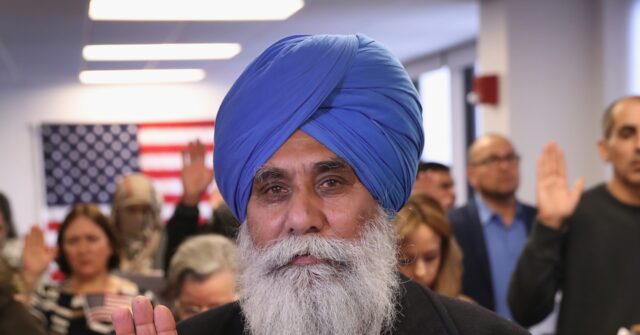Indian diplomats want the draft U.S.-India trade deal to welcome more Indian job-seekers into the United States, say U.S. and Indian media reports.
“Indian officials will ask US trade negotiators this week to ease access for thousands of skilled workers, a person familiar with the matter said, days after President Donald Trump’s abrupt announcement to restrict H-1B visas,” said a September 24 report in TheHinduBusinessLine.com.
The report, which is attributed to Bloomberg News, adds:
Indian negotiators led by Commerce Minister Piyush Goyal will raise the issue of movement of skilled professionals, such as IT workers, in their current round of trade talks in Washington, the person said, asking not to be identified because the discussions are private.
Trade talks up to now have centered around easing access for goods only, but Trump’s latest crackdown on [H-1B] immigration have pushed New Delhi to widen the negotiations to include services industries, such as IT. India’s economy is heavily skewed toward services, which make up more than 50 per cent of gross domestic product.
The reports suggested that India’s government wants to expand the one million-plus population of Indian graduates who are now in the white-collar jobs needed by Americans. Each year, at least 400,000 additional Indians arrive to work U.S. white-collar jobs legally or illegally, so pushing a huge number of American graduates into lower-tier jobs, such as coffee barista.
But Indians may also want to send more low-wage workers into U.S. jobs via the H-2A, H-2B, B-1, and M-1 visas for trade school students. Many Indian migrants use B-1 tourist visas to work as illegal truckers and cargo handlers on U.S. freeways.
India’s government may also be trying to get Trump to promise not to reduce the current huge inflow that has already crippled U.S. innovation and prosperity.
These 12 countries account for 77% of the 35-million strong Indian diaspora. Here’s where the most Indian immigrants live. Data Source: Insider Monkey. (Graphic by Visual Capitalist via Getty Images)
The Indian demands may have been leaked as a negotiating tactic to offset U.S. demands for Indian to buy more U.S exports of grain and oil products. India’s government is reluctant to allow more imports of grains because it would threaten the government’s support among the nation’s 140 million farmers.
But the U.S. public — and Trump — is very unlikely to support more Indian migration, despite huge pressure from self-serving Wall Street investors.
“The large-scale replacement of American workers through systemic abuse of the program [by India] has undermined both our economic and national security,” said the September 19 proclamation by Trump that established modest curbs on the H-1B program:
The number of foreign STEM workers in the United States has more than doubled between 2000 and 2019, increasing from 1.2 million to almost 2.5 million, while overall STEM employment has only increased 44.5 percent during that time. Among computer and math occupations, the foreign share of the workforce grew from 17.7 percent in 2000 to 26.1 percent in 2019. And the key facilitator for this influx of foreign STEM labor has been the abuse of the H-1B visa.
…
The abuse of the H-1B program is also a national security threat. Domestic law enforcement agencies have identified and investigated H-1B-reliant outsourcing companies for engaging in visa fraud, conspiracy to launder money, conspiracy under the Racketeer Influenced and Corrupt Organizations Act, and other illicit activities to encourage foreign workers to come to the United States.
“Any U.S. trade deal that links market access to more visas is a bad bargain for American workers,” said a September 24 note from U.S. Tech Workers.
Many skilled U.S. graduates are unable to secure career-starting jobs amid the current Indian migration.
But any U.S. investors want to import even more wage-cutting foreign graduates, regardless of the pocketbook and civic damage to Americans and their American society.
“How about doubling or tripling the number of H-1B visas?”‘ said a September 24 op-ed by immigrant investor Michael Moritz:
How about automatically offering not H-1B visas but full citizenship to any foreign national who receives a PhD degree in a STEM subject from the 50 highest calibre universities in the country?
…
Two of the finest chief executives in the US, Satya Nadella of Microsoft and Sundar Pichai of Google, are here because of the attitudes of prior administrations. Ditto for Hock Tan, CEO of Broadcom, Lip-Bu Tan, CEO of Intel, Shantanu Narayen, CEO of Adobe, Jensen Huang, CEO of Nvidia, Dara Khosrowshahi, CEO of Uber, and Elon Musk, CEO of the universe.
India’s government uses its millions of migrants to extract remittances and technology investment from the United States, the United Kingdom, Germany, and other countries. In 2024, roughly $33 billion in remittances were sent back to India from Indian workers in the United States. India also uses the Indian-born CEOs to redirect U.S. investments to India.
In prior negotiations with the United Kingdom and Japan, Indian officials have demanded that they open their borders to a rush of additional Indian migrants.
“The mobility of skilled workers is vital to India’s services exports, which rose over 12 per cent year-on-year to $383.5 billion in the financial year 2024–25, accounting for nearly half of the country’s total trade in goods and services, according to official data,” according to the HinduBusinessLine.com site.
The export of people also alleviates political conflicts over domestic taxation and distribution of foreign revenues, and the economic harms within India’s corrupt and overregulated economy.
Read the full article here


